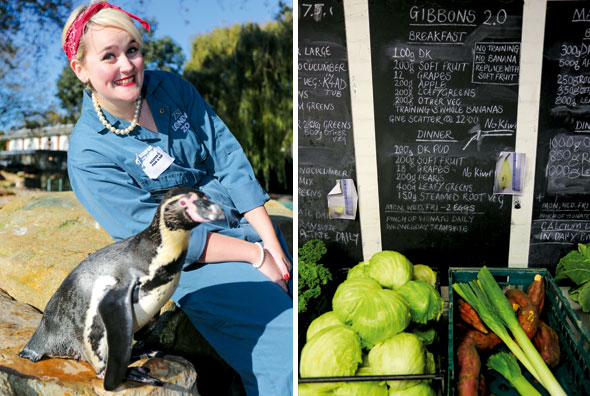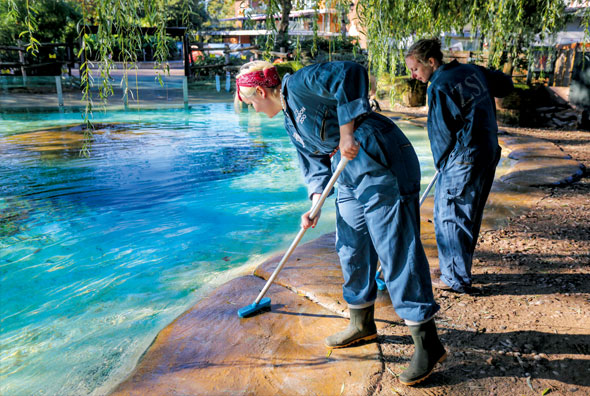My Penguin & Other Animals
The Zoological Society of London (ZSL) was founded by Stamford Raffles and other luminaries in 1826. It opened London Zoo two years later and Whipsnade Wild Animal Park, in Bedfordshire, followed in 1931. London Zoo is currently home to over 800 species, from tigers to reptiles, and is actively involved in breeding programmes for 130 species. And if you thought your pet cat, dog or guinea pig was a handful, try looking after this lot.
Fortunately, I am not alone. Specialist zookeeper Mick Tiley has been working at the zoo for nearly 34 years and is on hand to show me what it takes to do the job. These are wild animals – as shown by the recent incident at Whipsnade in which a keeper was seriously injured by a rhino – and I hang on Mick’s every instruction.
 From left: Pick up a penguin: One of London Zoo’s resident Humboldts makes a move on Melonie. The daily menus for the animals are chalked onto blackboards
From left: Pick up a penguin: One of London Zoo’s resident Humboldts makes a move on Melonie. The daily menus for the animals are chalked onto blackboards First task: mucking out the four zebras. En route, however, Mick introduces me to the Okapia johnstoni, a strange mammal that looks like a cross between a zebra and a giraffe. Harry Johnston, a British explorer, botanist, linguist and colonial administrator, who also happens to be an ancestor of Mick’s, was instrumental in bringing the okapi to the attention of science. No wonder he wants to show off this remarkable beast.
But we can’t keep the zebras waiting. The ones here are older than those at Whipsnade, and they like things just so. ‘It’s sort of a zebra retirement home,’ Mick laughs.
It doesn’t take long to clear away the soiled sawdust and replace it with clean bedding, and our next stop is the kitchen to prepare food for the zoo’s three female giraffes: Molly, Maggie and Ellish.
So what do they eat? Well, that depends. Mick tells me that sometimes they are fed white bread. It sounds a bit odd, but when the giraffes are ill, their medication is disguised in a sandwich. Giving them bread on a regular basis means they will happily wolf down medicated sandwiches when the need arises. This morning, however, carrots are the special of the day.

On the way to the headheight (that’s their head height) feeding platform, Mick, the font of all knowledge, as I like to think of him, tells me that when ZSL introduced giraffes in 1836, they were the first to come to Britain since Roman times.
With the carrots clearly in view, it isn’t long before we are joined by the trio. I’m told to make no sudden movements, to stand in front of them and to hold out a carrot. Before long, one sticks out its 18in tongue and takes the offering. ‘I love them to bits,’ says Mick. ‘It’s really calming working with them.’
Once the carrots are all gone (with a few thrown straight on the ground by the cheeky Maggie), it’s back to the kitchen to prepare lunch for six bearded pigs, the only ones in the UK. The bearded pig is the largest pig in the world, so when we head down to the kitchen and see the lunch menu (there really are menus for breakfast, lunch and dinner chalked onto blackboards on the wall) I’m not surprised by the quantity: 13 apples, three carrots, two potatoes, three beetroots, three oranges and a passion fruit – each. The pigs certainly get their five a day.
We also treat them to some coconuts as part of an ‘enrichment feed’. Enrichment feeds are used to keep the animals mentally and physically active, so we give them the coconuts whole and let them do the tricky work of cracking them open. It’s good for the mind, apparently.
 From top left: A baby colobus monkey clutches Melonie’s finger as she offers a special treat of steamed potato. A ring-tailed coati warms to Melonie.One of London Zoo’s six bearded pigs, which are the only ones in the UK
From top left: A baby colobus monkey clutches Melonie’s finger as she offers a special treat of steamed potato. A ring-tailed coati warms to Melonie.One of London Zoo’s six bearded pigs, which are the only ones in the UKNext stop: the beach. The penguin beach, that is. Nearly 80 Humboldt penguins live here, and it’s my job to clean up after them. They are certainly cute and cuddly in the John Lewis Christmas advert, but it would appear that real penguins do their ‘business’ wherever they please.
Among this colony of Humboldt penguins there’s also a single rockhopper. Ricky, as he is known, does not have a partner at the moment, and Mick informs me that they are only allowed to take one out of the wild in extreme circumstances. But Ricky doesn’t seem too bothered; he has taken a shine to Mick, bringing him a leaf and calling out to him much like he would to a mate in the wild.
‘He’s a lovely animal, Ricky, but don’t tell him that or it’ll go to his head,’ Mick says.
This is England’s largest penguin enclosure, and if we want to get closer to the penguins we must wait in the special meet-and-greet area. The penguins know that they will be approached by humans in this area and that they can stay away if they’d prefer some privacy. Luckily, they are an inquisitive bunch, and it’s not long before I get to be up close with some of them. Ricky, in particular, is very soft – Mick tells me Ricky has just moulted, so he is in particularly fine form.
 Giddy heights: Melonie gets to work feeding the giraffes
Giddy heights: Melonie gets to work feeding the giraffesAfter a quick stop for lunch, Mick and I give a steamed potato enrichment feed to the black-and-white colobus monkeys. In the past, primates in captivity tended to suffer with diabetes due to the amount of fruit they were fed. Now they are given more vegetables – although Mick tells me that they can be quite fussy and prefer their veg steamed. I hold out a piece of potato, and the baby of the group holds on to my fingers and enjoys my offering. My heart melts.
The llamas and the three alpacas (Del Boy, Trigger and Boycie) are next. Feeding them is much like feeding a horse: you keep your hand flat to avoid nips. They are voracious eaters, and their bucket of chopped cabbage, swede and other bits is soon gone.
In fact, the feeding process never seems to end, and we head via the ring-tailed coatis to the meerkats. Sadly, due to their very sharp teeth we are not allowed to stroke these beautiful little creatures, but watching them tuck in and enjoy their fruit mix is just as enjoyable.
 The penguin beach – Melonie works with another zookeeper to clean it up
The penguin beach – Melonie works with another zookeeper to clean it upPerhaps the strangest part of the schedule is pretending to be a finch – for Galapagos giant tortoises. In the wild, birds called Darwin’s finches pick off parasites from around the neck and legs of the tortoise. The tortoise will stand high on its legs and stretch out its neck as far as possible, signalling that it is ready for the finches to come and feed. In captivity, however, this job falls to humans. Wearing rubber gloves, we massage the tortoises, simulating the effect.
Over the course of the day, it’s hard not to warm to Mick. Not only does he have a fabulously dry sense of humour, but his enthusiasm for his work, the work of ZSL and the animals simply bursts out of him. The animals are, of course, the main attraction, but Mick gives everything a whole other dimension.
 From left: It’s gloves on at massage time for a Galapagos giant tortoise. Love a llama – Melonie makes yet another friend
From left: It’s gloves on at massage time for a Galapagos giant tortoise. Love a llama – Melonie makes yet another friendMeanwhile, as well as giving you the chance to see the animals – furry, scaled and feathered – up close, ZSL’s Keeper For A Day events, as Mick stresses, are important for the animals too. In addition to providing funds for essential conservation work, they help get the animals used to human interaction, making them more willing to be treated by a vet if they should ever fall ill.
Who would have thought that a day at the zoo could be so rewarding? And enlightening, too.
For more information on ZSL London Zoo: 020-7449 6200, www.zsl.org/zsl-london-zoo



